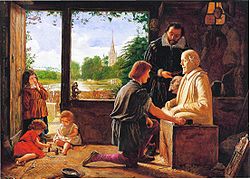
Gerard Johnson (sculptor)
Encyclopedia

Shakespeare's funerary monument
The Shakespeare funerary monument is a memorial to William Shakespeare located inside Holy Trinity Church, Stratford-upon-Avon, Warwickshire, UK, the same church in which Shakespeare was baptised....
.
His father, also called Gerard Johnson, came to England in 1567 from Holland. He established himself as a sculptor of funerary monuments in London. Johnson's father had worked on a monument to the 1st Earl of Southampton
Thomas Wriothesley, 1st Earl of Southampton
Thomas Wriothesley, 1st Earl of Southampton, KG , known as The Lord Wriothesley between 1544 and 1547, was a politician of the Tudor period born in London to William Wrythe and Agnes Drayton....
, which also depicts Shakespeare's patron, the 3rd Earl
Henry Wriothesley, 3rd Earl of Southampton
Henry Wriothesley , 3rd Earl of Southampton , was the second son of Henry Wriothesley, 2nd Earl of Southampton, and his wife Mary Browne, Countess of Southampton, daughter of the 1st Viscount Montagu...
, as a young man. Shakespeare would probably have seen the monument if he had stayed at Titchfield
Titchfield
Titchfield is a village in southern Hampshire, by the River Meon. The village has a history stretching back to the 6th century. During the medieval period, the village operated a small port and market...
.
The younger Johnson's monument is in Holy Trinity church, Stratford upon Avon, and was probably commissioned by Shakespeare's son-in-law John Hall
John Hall (physician)
John Hall was a physician and son-in-law of William Shakespeare.-Life:He was born at Carlton, Bedfordshire and studied at Queens' College, Cambridge from 1589, receiving a B.A. in 1593 and a M.A. in 1597...
. The attribution to Johnson is contained in William Dugdale
William Dugdale
Sir William Dugdale was an English antiquary and herald. As a scholar he was influential in the development of medieval history as an academic subject.-Life:...
's Antiquities of Warwickshire, published in 1656, but no other evidence of Johnson's authorship exists. Dugdale also states that the younger Johnson created the memorial in Holy Trinity church to Shakespeare's friend John Combe, who left the playwright a legacy in his will. This would probably have been installed in 1615 while Shakespeare was still alive. It is also possible that Shakespeare knew the Johnson family from his London days, since their workshop was close to the Globe theatre
Globe Theatre
The Globe Theatre was a theatre in London associated with William Shakespeare. It was built in 1599 by Shakespeare's playing company, the Lord Chamberlain's Men, and was destroyed by fire on 29 June 1613...
.
In 1849 a death mask was discovered in Germany, and was claimed to be Shakespeare's. It received great publicity when the anatomist
Comparative anatomy
Comparative anatomy is the study of similarities and differences in the anatomy of organisms. It is closely related to evolutionary biology and phylogeny .-Description:...
Richard Owen
Richard Owen
Sir Richard Owen, FRS KCB was an English biologist, comparative anatomist and palaeontologist.Owen is probably best remembered today for coining the word Dinosauria and for his outspoken opposition to Charles Darwin's theory of evolution by natural selection...
authenticated it and suggested that it was used by Johnson as the model for the memorial. Henry Wallis later painted this imagined scene validating the mask. The mask is no longer considered to be authentic.

